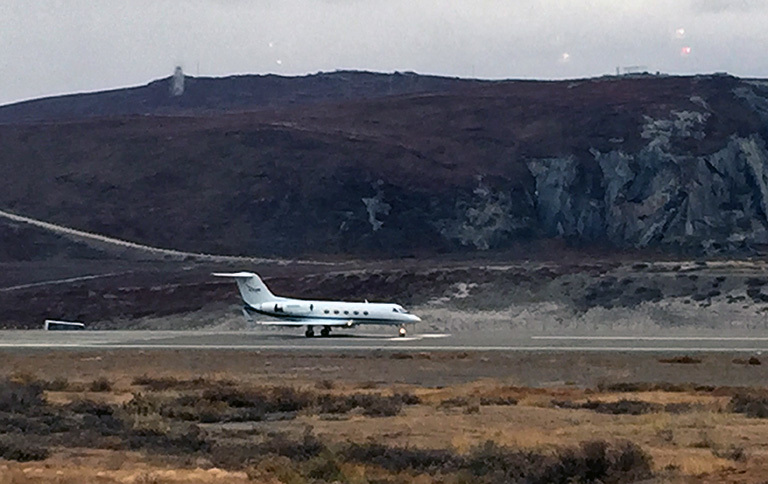Ask NASA Climate | October 3, 2016, 14:00 PDT
Swoosh

NASA’s G-III about to take off from Kangerlussuaq Airport, Greenland, for a day of ocean science research.
Swoosh! It’s not a sound so much as a feeling. You feel it in your ears and through your whole body. And everyone on the plane — two NASA G-III pilots, two flight engineers and the rest of the Oceans Melting Greenland (OMG) crew—feels it at exactly the same time. It has become our inside joke.
The swoosh happens every time the flight engineers drop an Aircraft eXpendable Conductivity Temperature Depth (AXCTD) probe through a hole in the bottom of the plane. The AXCTD comes in a 3-foot-long gray metal tube—with a parachute. After it hits the water, the probe measures ocean temperature and salinity from the sea surface down to about 1,000 meters. The tiny difference between cabin and outside pressure pushes the probe out and makes ears pop at the same time.
This is the second week of our three- to four-week mission that will be repeated every September/October for the next five years. We’re finally starting to iron out all the minor details in our protocol. With so many moving parts, the protocol is important, and the intricate timing helps us make sure no one forgets any details and we get the most accurate record of when and where we drop each one.
- Project Manager Steve Dinardo announces “Data recorder ready.”
- Pilots Bill Ehrenstrom and Scott Reagan call out the cloud and ice conditions and the number of minutes to the drop site. Then they determine the altitude for the approach.
- Flight Engineers Terry Lee and Phil Vaughn announce “Tube positioned and ready.”
- At 50 seconds from the drop site, the plane slows down and cruises at about 5,000 feet.
- At 20 seconds, Lee and Vaughn open the cap of the tube—you know, the one with that hole through the bottom of the plane—and everyone’s ears pop (the first time). Protocol states that they announce “Tube open!” but since our ears just popped, we often hear “Well, of course the tube’s open” or “As you already know—tube’s open.”
- At 10 seconds, the pilots count down to 1 and say “drop.” The engineers reply “Sonde’s away” and we all feel that swoosh. There it is. Our ears pop for the second time as the AXCTD is “swooshed” down the tube and out through the hole in the bottom of the plane. (And yes, we all still look at each other with our sly smiles because it’s so much fun to say, “hole in the bottom of the plane.”)
- It is the swoosh, more than anything said during the lengthy protocol script playing through my headset, that tells me—OMG lead scientist Josh Willis—to mark the drop on my GARMIN, a GPS we use to record the location of each drop.
- After each drop, our aircraft banks steeply and we all silently celebrate the fact that we don’t get motion sickness. We continue circling during the six or so minutes it takes for the science probe to parachute down 5,000 feet to the sea surface and make its way through the water column, sending back data to us in real-time on the plane.
During our many, often challenging hours on the plane together, we share these little inside jokes and laugh—not caring if anyone in the outside world thinks it’s funny. Seems like we are bonding. I couldn’t be happier.
Find out more about Oceans Melting Greenland.
View and download OMG animations and graphics.
Thank you for your comments.
Laura
Oceans Melting Greenland is part of NASA Earth Expeditions, a six-month field research campaign to study regions of critical change around the world.
